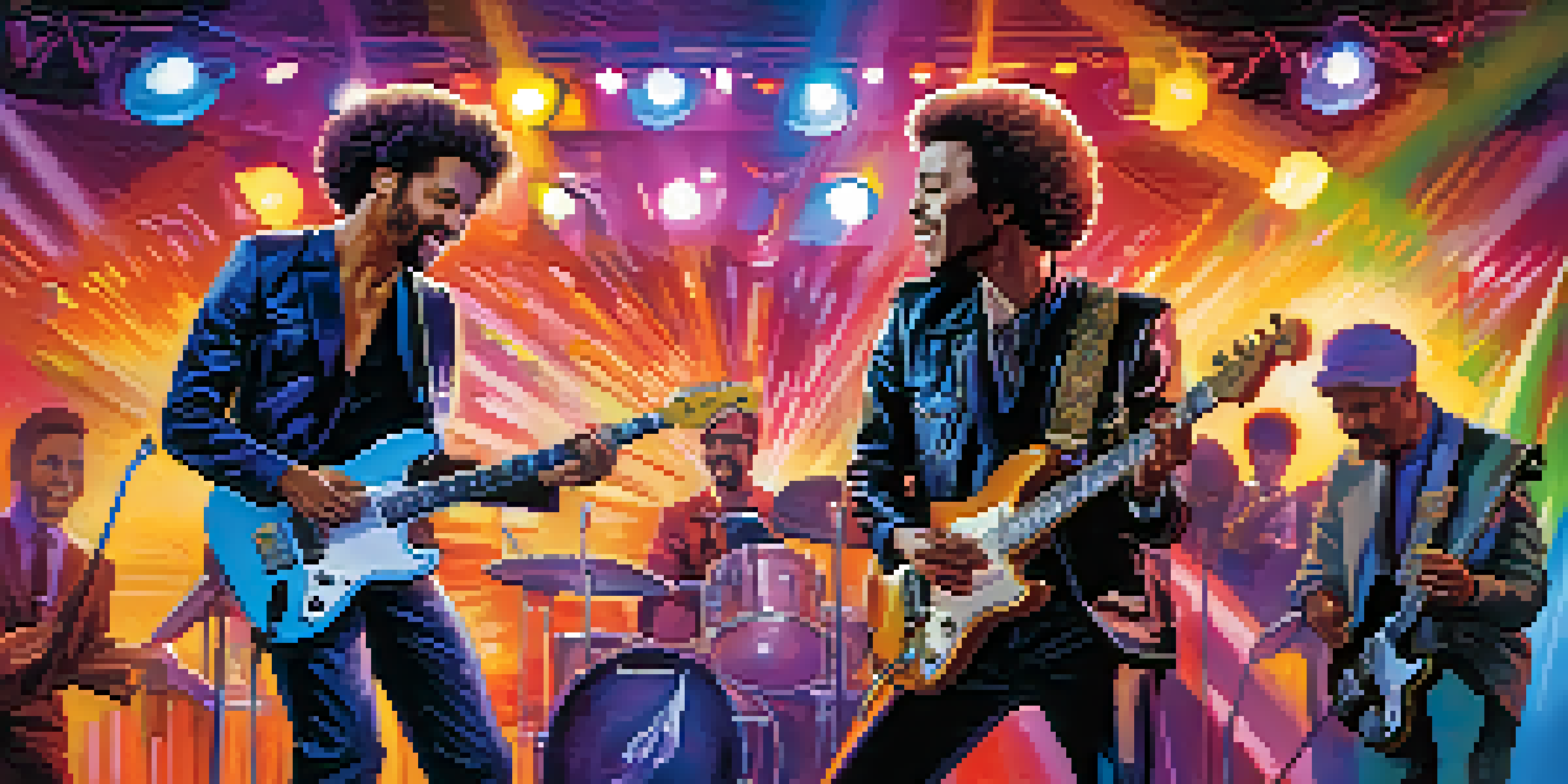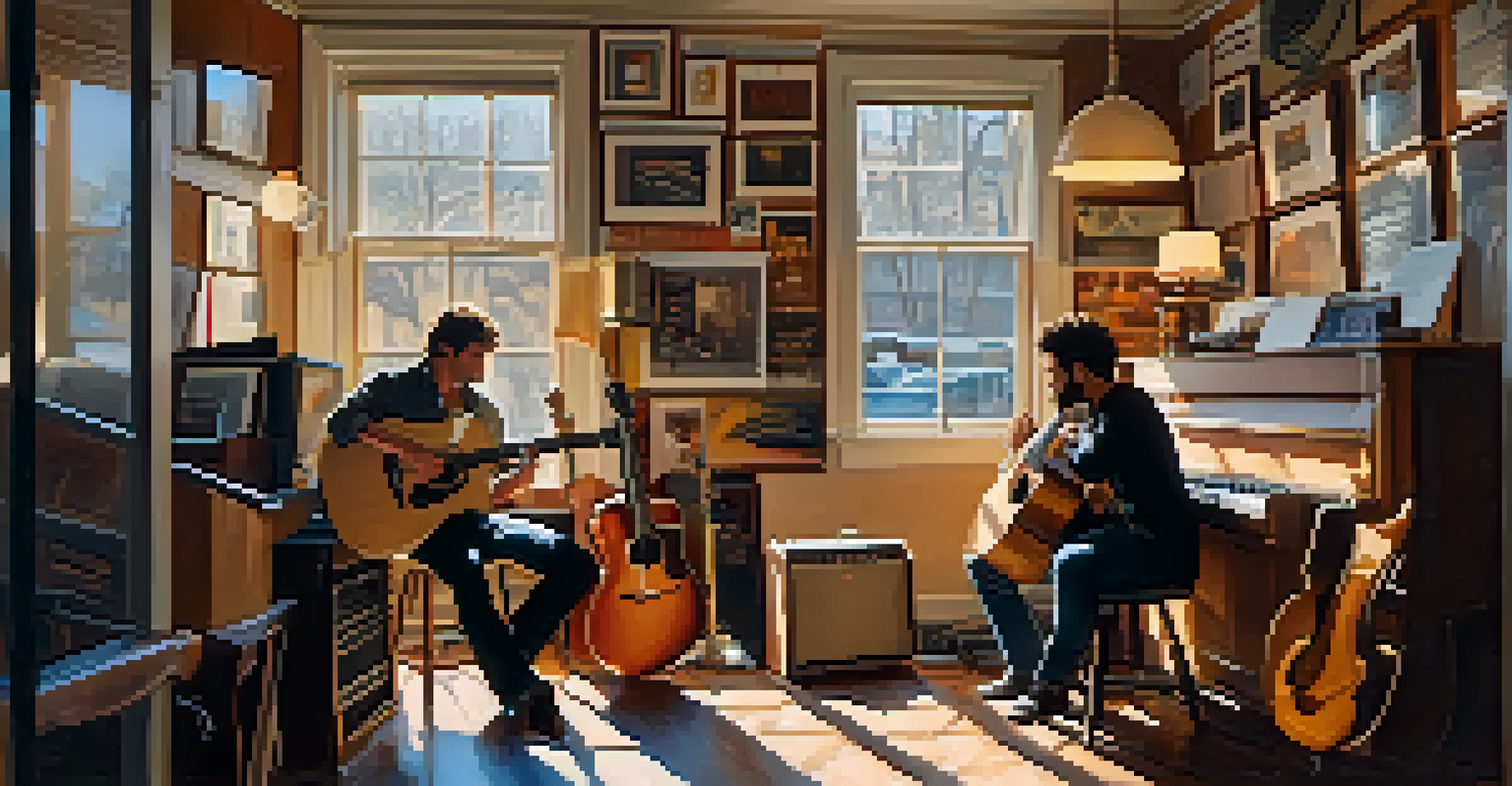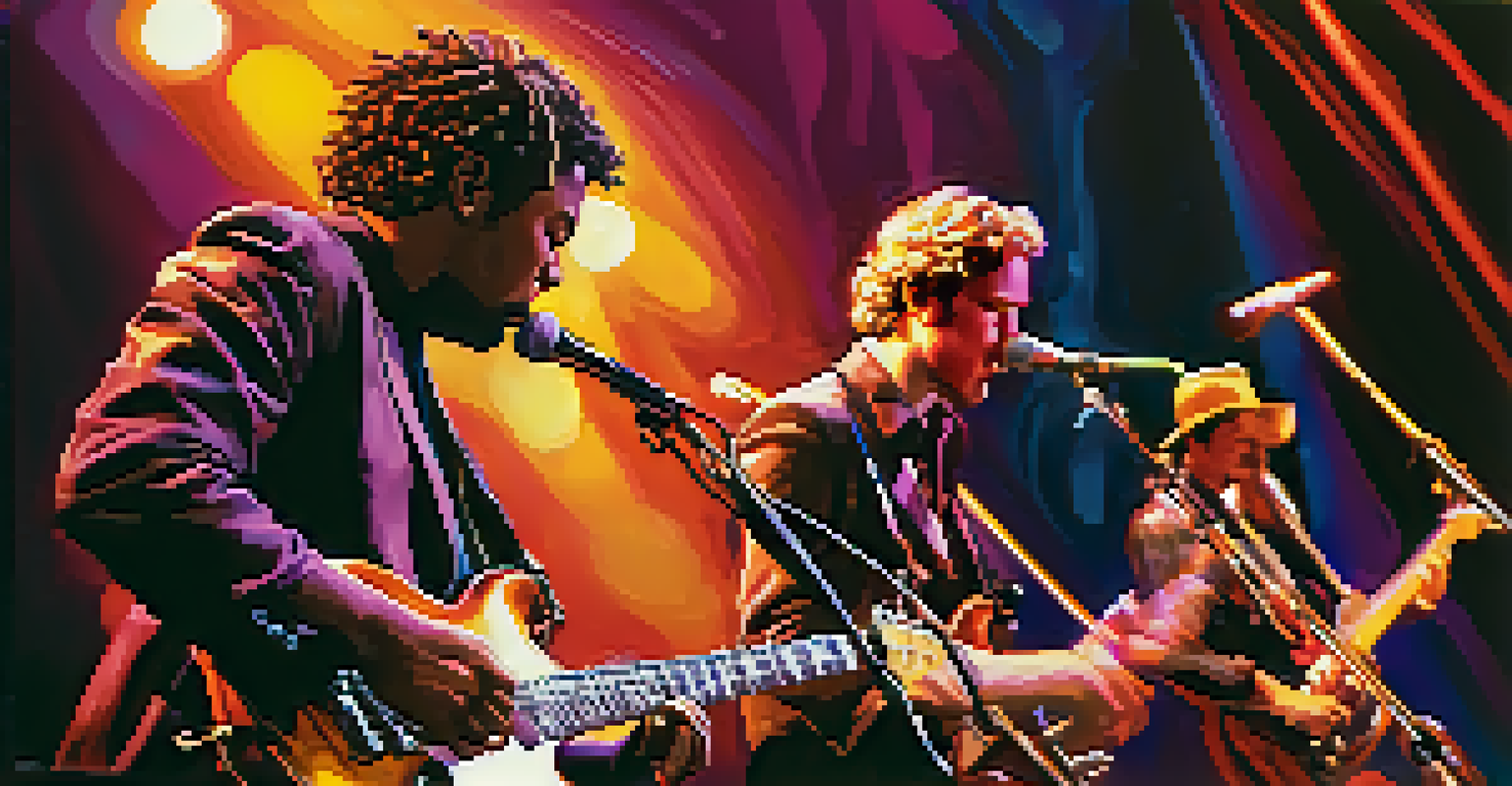Bridging Genres: Guitarists Collaborating with Jazz Musicians

The Magic of Genre Fusion in Music
Music has always been about breaking boundaries, and genre fusion is one of the most exciting ways to explore creativity. When guitarists collaborate with jazz musicians, they create a unique sound that resonates with a wide array of listeners. This blending of styles not only enriches the music but also challenges the artists to step out of their comfort zones and embrace new techniques.
Without deviation from the norm, progress is not possible.
For example, a rock guitarist might find themselves experimenting with improvisation techniques that are central to jazz. This can lead to unexpected and thrilling musical moments, showcasing the versatility of the guitar. The result is often a compelling soundscape that can appeal to fans of both genres, demonstrating the power of collaboration.
Ultimately, genre fusion opens the door for innovation, inviting musicians to share their unique perspectives and influences. The collaboration can lead to fresh compositions that reflect a combination of personal experiences and musical backgrounds, creating a beautiful tapestry of sound.
Iconic Collaborations: A Brief Overview
Throughout music history, there have been several iconic collaborations between guitarists and jazz musicians that have left a lasting impact. Think of legends like Jimi Hendrix, who intersected rock and jazz with his improvisational style, or Pat Metheny, a jazz guitarist who has worked with various rock artists. These partnerships not only highlight each musician's strengths but also encourage fans to explore new musical territories.

One particularly noteworthy collaboration is between Eric Clapton and jazz guitarist John McLaughlin. Their album 'The Meeting of the Spirits' is a brilliant example of how different genres can come together to create something entirely new. Such efforts not only elevate the artists involved but also inspire listeners to appreciate the nuances of both genres.
Genre Fusion Sparks Creativity
Collaborations between guitarists and jazz musicians lead to innovative sounds that enrich both genres.
These collaborations showcase that music is a universal language, capable of bridging divides. By blending different styles, artists can create timeless music that transcends genre boundaries and resonates with diverse audiences.
The Role of Improvisation in Guitar-Jazz Collaborations
Improvisation is a cornerstone of jazz music, and when guitarists engage in collaborative projects, it often becomes a focal point. This spontaneous creation allows musicians to respond to one another in real-time, leading to captivating performances filled with surprises. For guitarists, stepping into the world of jazz improvisation can be both challenging and exhilarating, pushing their skills to new heights.
Music can change the world because it can change people.
A great example of this is the collaboration between guitarist Bill Frisell and jazz saxophonist Charles Lloyd. Their performances are marked by a beautiful interplay of spontaneous melodies that reflect the emotions of the moment. This type of improvisational synergy not only captivates audiences but also strengthens the bond between the musicians involved.
Through improvisation, guitarists can explore new techniques and harmonic structures, enriching their overall musicianship. The beauty of this process lies in its unpredictability; no two performances are ever the same, making each collaboration a unique experience for both the artists and the audience.
How Genres Influence Guitar Techniques
The interaction between guitarists and jazz musicians often leads to the cross-pollination of techniques that can enhance each genre. Guitarists may adopt jazz techniques like fingerstyle or alternate picking, while jazz musicians might incorporate more aggressive rock rhythms into their playing. This blending of approaches not only diversifies their skill sets but also enriches their musical expression.
For instance, a guitarist accustomed to rock may find themselves exploring jazz's complex chord progressions or syncopated rhythms. This exploration can lead to a more versatile playing style, enabling them to adapt to various musical contexts. It’s a win-win for both parties, as they expand their musical vocabulary.
Improvisation Enhances Collaboration
Improvisation serves as a key element in these partnerships, allowing musicians to create captivating and spontaneous performances.
Moreover, these shared techniques can lead to innovative compositions that capture the essence of both genres. The resulting music often features a rich tapestry of sounds, inviting listeners to appreciate the nuances of each style while enjoying the seamless integration of them.
The Impact on Audience and Fan Base
Collaborations between guitarists and jazz musicians have the power to attract a diverse audience, drawing fans from both genres. This crossover appeal introduces listeners to new music they may not have explored otherwise. It's exciting to see how one artist’s following can influence another, creating a shared space for appreciation and discovery.
For example, when a well-known rock guitarist teams up with a jazz legend, fans of both genres often come together at concerts. They find common ground in the music, fostering a sense of community and shared experience. This blending of fan bases can lead to increased engagement and a broader appreciation of different musical styles.
Ultimately, these collaborations enrich the concert experience, allowing audiences to witness the unique chemistry between artists. It creates a vibrant atmosphere where fans can celebrate the beauty of music, irrespective of genre, while discovering new favorites along the way.
Future Trends in Genre Collaboration
As music continues to evolve, we’re seeing more artists willing to experiment with genre blending. The rise of technology and social media has made it easier for musicians to connect and collaborate, leading to exciting new projects. We can expect to see even more guitarists and jazz musicians coming together to create innovative sounds that push the boundaries of traditional genres.
Emerging artists are increasingly influenced by a wide array of musical styles, making genre fusion a natural progression in their creative journey. Collaborations can take various forms, from live performances to studio recordings, and the possibilities are endless. This trend not only sparks creativity among musicians but also keeps the music scene fresh and exciting.
Diverse Audiences Unite Through Music
These genre-blending collaborations attract a diverse fan base, fostering community and appreciation for different musical styles.
Moreover, as listeners become more open to diverse sounds, the demand for genre-blending music is likely to increase. This creates an encouraging environment for artists to take risks, leading to a richer musical landscape that reflects the complexity of modern influences.
Conclusion: Celebrating Musical Diversity
In conclusion, the collaboration between guitarists and jazz musicians exemplifies the beauty of musical diversity. These partnerships not only enhance the artists' creative processes but also enrich the listening experience for audiences. By embracing different genres, musicians can create innovative compositions that resonate with a wide range of listeners.
As we celebrate these collaborations, it’s important to appreciate the unique contributions each genre brings to the table. The fusion of styles allows for new perspectives and creative expression, resulting in music that transcends boundaries. This celebration of diversity is a reminder of the universal nature of music and its ability to connect people.

Whether you're a fan of rock, jazz, or both, there's something magical about witnessing artists collaborate across genres. As we look to the future, we can only anticipate the exciting new sounds that will emerge from these creative partnerships, enriching the musical landscape for years to come.